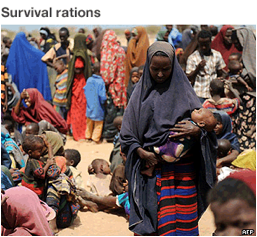Over the last week or so, leading up the Christmas 2013, I have watched the television and been filled with horror at the images of one child every three seconds dying of starvation on the Horn of Africa, part of the so-called Developing World. Yet, at one and the same time, obesity is killing people in the Developed World. Many people in the United States of America and no doubt in Australia, consume more than twice as many kilojoules every day, than they require for a healthy life.

In the lifetime of my grandchildren the population of the world will increase from six billion to nine billion. Most of that increase will be in the Developing World.
In our world, the Developed World, there is no shortage of food. In fact, we are so wealthy; we can choose what food we eat — the variety is endless and obesity is a major health problem, especially in children.
We can not only choose what variety of food we eat, we can choose what kind of food we eat — so vegetarians and vegans can purchase a balanced diet free of those items they have chosen not to eat, and meat eaters, carnivores as my daughter calls us, find our choices are almost endless.
As we wander the aisles of the supermarket taking our time making our choices, every three seconds one child dies of starvation on the Horn of Africa. Continue reading “The Horn of a Dilemma”


